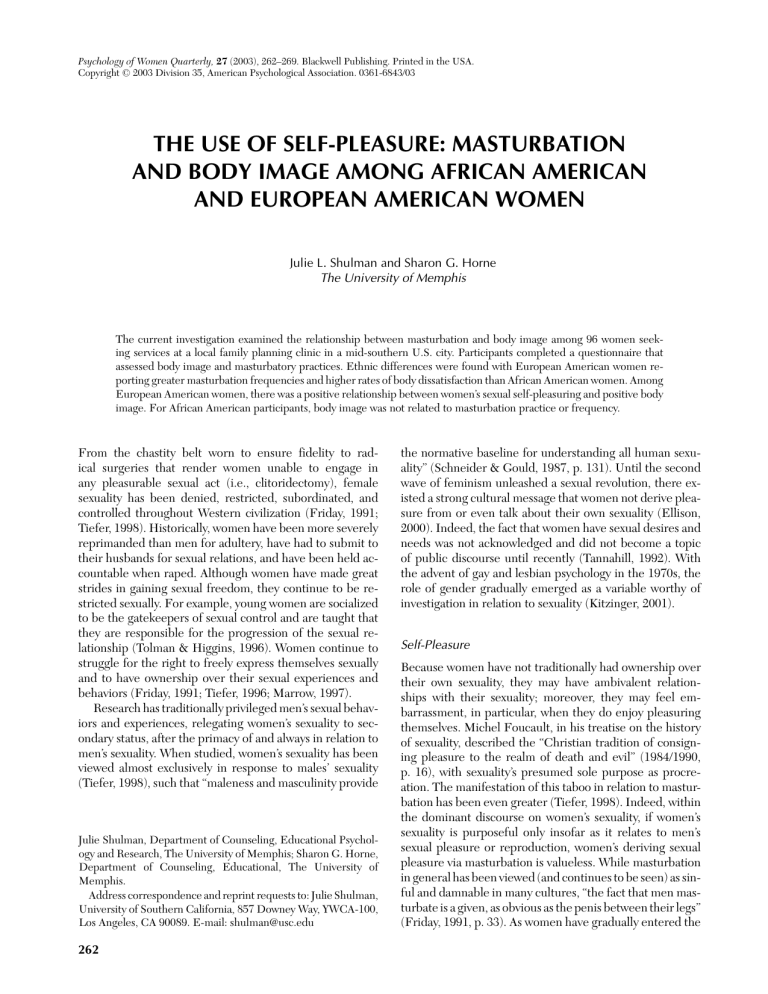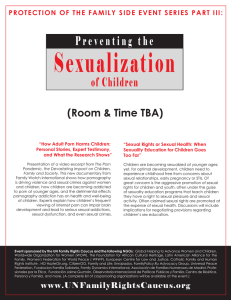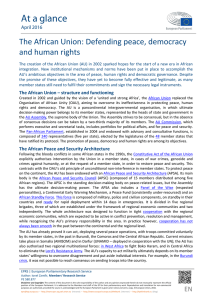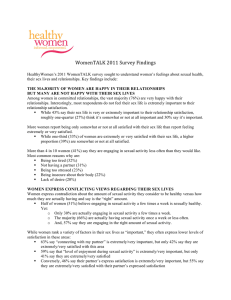
Psychology of Women Quarterly, 27 (2003), 262–269. Blackwell Publishing. Printed in the USA. C 2003 Division 35, American Psychological Association. 0361-6843/03 Copyright THE USE OF SELF-PLEASURE: MASTURBATION AND BODY IMAGE AMONG AFRICAN AMERICAN AND EUROPEAN AMERICAN WOMEN Julie L. Shulman and Sharon G. Horne The University of Memphis The current investigation examined the relationship between masturbation and body image among 96 women seeking services at a local family planning clinic in a mid-southern U.S. city. Participants completed a questionnaire that assessed body image and masturbatory practices. Ethnic differences were found with European American women reporting greater masturbation frequencies and higher rates of body dissatisfaction than African American women. Among European American women, there was a positive relationship between women’s sexual self-pleasuring and positive body image. For African American participants, body image was not related to masturbation practice or frequency. From the chastity belt worn to ensure fidelity to radical surgeries that render women unable to engage in any pleasurable sexual act (i.e., clitoridectomy), female sexuality has been denied, restricted, subordinated, and controlled throughout Western civilization (Friday, 1991; Tiefer, 1998). Historically, women have been more severely reprimanded than men for adultery, have had to submit to their husbands for sexual relations, and have been held accountable when raped. Although women have made great strides in gaining sexual freedom, they continue to be restricted sexually. For example, young women are socialized to be the gatekeepers of sexual control and are taught that they are responsible for the progression of the sexual relationship (Tolman & Higgins, 1996). Women continue to struggle for the right to freely express themselves sexually and to have ownership over their sexual experiences and behaviors (Friday, 1991; Tiefer, 1996; Marrow, 1997). Research has traditionally privileged men’s sexual behaviors and experiences, relegating women’s sexuality to secondary status, after the primacy of and always in relation to men’s sexuality. When studied, women’s sexuality has been viewed almost exclusively in response to males’ sexuality (Tiefer, 1998), such that “maleness and masculinity provide Julie Shulman, Department of Counseling, Educational Psychology and Research, The University of Memphis; Sharon G. Horne, Department of Counseling, Educational, The University of Memphis. Address correspondence and reprint requests to: Julie Shulman, University of Southern California, 857 Downey Way, YWCA-100, Los Angeles, CA 90089. E-mail: [email protected] 262 the normative baseline for understanding all human sexuality” (Schneider & Gould, 1987, p. 131). Until the second wave of feminism unleashed a sexual revolution, there existed a strong cultural message that women not derive pleasure from or even talk about their own sexuality (Ellison, 2000). Indeed, the fact that women have sexual desires and needs was not acknowledged and did not become a topic of public discourse until recently (Tannahill, 1992). With the advent of gay and lesbian psychology in the 1970s, the role of gender gradually emerged as a variable worthy of investigation in relation to sexuality (Kitzinger, 2001). Self-Pleasure Because women have not traditionally had ownership over their own sexuality, they may have ambivalent relationships with their sexuality; moreover, they may feel embarrassment, in particular, when they do enjoy pleasuring themselves. Michel Foucault, in his treatise on the history of sexuality, described the “Christian tradition of consigning pleasure to the realm of death and evil” (1984/1990, p. 16), with sexuality’s presumed sole purpose as procreation. The manifestation of this taboo in relation to masturbation has been even greater (Tiefer, 1998). Indeed, within the dominant discourse on women’s sexuality, if women’s sexuality is purposeful only insofar as it relates to men’s sexual pleasure or reproduction, women’s deriving sexual pleasure via masturbation is valueless. While masturbation in general has been viewed (and continues to be seen) as sinful and damnable in many cultures, “the fact that men masturbate is a given, as obvious as the penis between their legs” (Friday, 1991, p. 33). As women have gradually entered the The Use of Self-Pleasure: The Role of Ethnicity in Body Image and Masturbation discussion around sexuality, especially in the feminist sexology literature (Tiefer, 1996), their self-pleasuring via masturbation has been increasingly accepted as one form of sexual satisfaction. Since masturbation as a means of sexual satisfaction often occurs outside of a relationship, it can be perceived as a threat insofar as it means that women are empowering themselves and gaining autonomy and control over their sexual pleasure (Friday, 1991; Tiefer, 1996). Indeed, women engage in sexual self-pleasuring activities for a variety of reasons. These multiple reasons have been discussed by many sex therapists, especially feminists, who view masturbation as a viable and enjoyable activity for many women (Tiefer, 1996). Women’s sexual self-pleasuring has been described as a metaphor for independence or empowerment (Tiefer, 1995; Tiefer, 1996). By satisfying themselves sexually, women are not compelled to rely upon a man sexually. Additionally, by relying on oneself for sexual enjoyment, a woman can “reframe . . . the purposes of sexuality” (Tiefer, 1996, p. 59), focusing on pleasure in lieu of procreation, performance, or achievement (i.e., reaching orgasm), the latter of which is usually the focus in most heterosexual sexual relationships. Sex therapists commonly recommend masturbation to women to help them become more self-loving or to increase their self-esteem (McCormick, 1994; Tiefer, 1998). In their study of women who reported masturbating, Hurlbert and Whittaker (1991) found that those who had experienced masturbatory orgasms had higher levels of self-esteem than those women who had not experienced masturbatory orgasm. Given also that levels of self-esteem decrease as girls mature (AAUW, 1991; Rieves & Cash, 1996), the relationship between masturbation and a positive sense of self is important to explore. Clinicians have also viewed masturbation as a viable option for women as a means of learning about, becoming comfortable with, and appreciating their bodies (Ellison, 2000; Tiefer, 1996; Zoldbrod, 1998). In Ellison’s large-scale study, many women reported that masturbating is an effective method to soothe themselves. Others spoke about masturbating out of curiosity about their bodies. Comfort with their bodies is important, especially given the shame, insecurity, and dissatisfaction many women feel in relation to their bodies (Latteier, 1998; Pliner, Chaiken, & Flett, 1990; Saltzberg & Chrisler, 1995). In her article describing feminist sex therapy, Tiefer (1996) explains the necessity of what she calls “body image reclamation” for women; in other words, “women need to move from experiencing their bodies as primarily the focus of comparison-based appearance appraisal to experiencing their bodies as ever-changing individualized sources of sensations and competencies” (p. 58). Not only does Tiefer suggest that women must appreciate their own unique body shapes and sensations in order to be satisfied with their bodies, she also implies that women can achieve body appreciation through sexual selfexploration and pleasuring. 263 An acceptance of masturbation among women is seen more readily among European American women than among African American women (Laumann & Mahay, 2002; Wilson, 1986). For example, the National Health and Social Life Survey (Laumann, Gagnon, Michael, & Michaels, 1994) found that more European American women (44%) report ever masturbating than African American women (32%). Indeed, many have discussed a prevailing African American discourse that eschews masturbation, especially among women (Laumann & Mahay, 2002; Staples, 1972; Wilson, 1986). Wilson (1986) suggested that this common stance is at least partly due to a strong belief that masturbation is immoral, combined with a high regard for sexual morality, among African Americans. Body Image and Ethnicity The potential connection between masturbation and body image is noteworthy in light of the high prevalence of body dissatisfaction experienced by women and girls. The pervasiveness of body dissatisfaction among women has been well documented (e.g., Cash & Henry, 1995; Striegel-Moore, Silberstein, & Rodin, 1986). In a representative survey of women conducted in 1993 throughout the United States, Cash and Henry (1995) found substantial levels of body dissatisfaction, with one-half of the respondents reporting globally negative appearance evaluations and excessive preoccupation with being or becoming overweight. In fact, these results surpassed the levels of body dissatisfaction reported in a similar survey taken 10 years earlier. Both the prizing of the super-thin woman as the ideal body prototype and the high levels of body dissatisfaction among women have been implicated in the high risk for disordered eating among women (Bordo, 1993; Rothblum, 1994; Striegel-Moore et al., 1986). Indeed, the eating disorders literature is replete with studies that find an intimate connection between body dissatisfaction and eating disorders (Mazzeo, 1999; Osvold & Sodowsky, 1993; Striegel-Moore et al., 1986). Although the strides that have been made in developing effective interventions for women experiencing body dissatisfaction and eating disorders are important, body dissatisfaction is not limited to patient populations. Indeed, it is generally recognized that such dissatisfaction has become a “normative discontent” (Striegel-Moore et al., 1986). As such, the dissatisfaction with body size and shape appears to be a common phenomenon experienced by the majority of women in our culture (Cash & Henry, 1995). Exploring the connections between body dissatisfaction and its potential correlates has been a major effort in the body image literature (Rothblum, 1994; Smith, Thompson, Raczynski, & Hilner, 1999; Striegel-Moore et al., 1986). Although a few studies have investigated the connection between body image and sexual self-pleasuring among women diagnosed with an eating disorder (Wiederman, Pryor, & Morgan, 1996; Wiederman & Pryor, 1997), research to date has not 264 explored this connection among women without eating disorders. Due to the widespread problem of body dissatisfaction among women, this plausible connection is worthy of investigation. To date, most researchers in the field of body dissatisfaction and eating disorders have found that African American women are less influenced than European American women by this societal ideal for women to be thin and less likely to view themselves as overweight (Abrams, Allen, & Gray, 1993; Desmond, Price, Hallinan, & Smith, 1989). The prevalence of eating disorders has been significantly higher among European American women than among African American women (Gray, Ford, & Kelly, 1987; Story, French, Resnick, & Blum, 1995). Studies have consistently found that African American women are generally more satisfied with their bodies than are European American women (Akan & Grilo, 1995; Cash & Henry, 1995; Kemper, Sargent, Drane, Valois, & Hussey, 1994), despite the fact that African American women typically have higher body mass indexes or weight to height ratios (Abood & Chandler, 1997; Kemper et. al., 1994). Cash and Henry’s (1995) survey revealed significant ethnicity differences in body image, with African American women reporting more positive body images than European American women. Indeed, Root (1990) has described a possible “cultural protection” among African American women against developing eating disorders, maintained by a greater appreciation of a healthy body size and a wider range of what is considered to be an attractive female body in many African American communities. In fact, in their study of adolescent males’ perceptions of ideal body size that used body size drawings to assess preferences, Thompson, Sargent, and Kemper (1996) found that the African American boys preferred a significantly heavier ideal female body size than the European American boys. Some theorists have argued that the thinness ideal is simply not a part of African American culture but rather an influential force dominant in the European American mainstream culture (Gray et al., 1987; Striegel-Moore et al., 1986). Nevertheless, individuals within a particular ethnic group are still exposed to the norms of the dominant culture and, as Root (1990) pointed out, African Americans may be even more vulnerable because, as a group, they are largely devalued by the dominant culture. Self-Pleasure and Body Satisfaction In Ellison’s (2000) large-scale study, women reported that their negative feelings about their bodies interfere with sexual pleasure with a partner. The participants specifically attributed this connection between body image and sexual pleasure to feeling embarrassed about their bodies. Whether negative feelings about their bodies similarly interfere with sexual self-pleasuring is unknown. SHULMAN AND HORNE Gupta and Schork (1995) found that women who desired more tactile nurturance were more dissatisfied with their bodies, suggesting that a “deficit” in touch relates to negative body image. Interestingly, among women diagnosed with anorexia nervosa, a psychological disorder that is characterized by body dissatisfaction, masturbation was inversely related to caloric restriction (Wiederman, Pryor, & Morgan, 1996). Wiederman and Pryor (1997) also found that, among women diagnosed with bulimia nervosa, body satisfaction was related to masturbation experience, with women reporting more satisfaction with their bodies also more likely to have masturbated. These findings suggest, at least among clinical populations seeking treatment for eating disorders, that a positive relationship exists between masturbation and body satisfaction. Despite the literature showing a relationship between body satisfaction and masturbation among women in treatment for eating disorders, no empirical investigation has specifically examined the relationship between masturbation and body satisfaction among women who are not in treatment. In addition, the research on ethnic and racial differences among women in body image and masturbation suggests that exploration of the ways African American and European American women experience their bodies and self-pleasure is worthy of investigation. The current study examined ethnicity and body satisfaction in relationship to masturbatory practices among women without clinically diagnosed eating disorders. Based on the consistent findings that African American women report higher rates of body satisfaction, it was hypothesized that African American women in this sample would have higher rates of body satisfaction than European American women. Further, based on the connection between self-pleasuring and body satisfaction among women in treatment for eating disorders in conjunction with clinical lore about a positive relationship between masturbation and positive body image, it was hypothesized in the current study that a positive relationship would be found between masturbation and body satisfaction. Taken together, then, these hypotheses imply that African American women might be more likely to masturbate than European American women. However, the literature on African American women’s sexuality suggests instead that African American women might be less inclined to sexually pleasure themselves. This seemingly complex relationship between body satisfaction and masturbation across ethnicity was explored in post hoc analyses. METHOD Participants Participants were women seeking services at a regional Planned Parenthood, a family planning clinic. A total of 100 women completed the survey. Because there were four women who did not report their ethnicity as European The Use of Self-Pleasure: The Role of Ethnicity in Body Image and Masturbation American or African American, these women were dropped from the analyses. Therefore, the analyses included 96 women. By accessing women from this setting, an ethnically diverse sample of women was included as participants. Of these 96 women, 51 were African American and 45 were European American. A further strength of the study was that the sample consisted primarily of women of lower socioeconomic status, a group typically neglected in the research on sexuality (Ellison, 2000; Saris & JohnstonRobledo, 2000). Forty percent of the women reported a yearly income of less than $10,000, 28% reported earning between $10,000 and $20,000, 18% reported an income between $21,000 and $30,000, 9% reported a yearly income between $31,000 and $40,000, and 4% of the women reported a yearly income over $40,000. Participants ranged in age from 18 to 49 years old. Thirtyseven percent were between 18 and 23 years old, 43% were between 24 and 29 years old, 17% were between 30 and 39 years old, and 4% were between 40 and 49 years old. The majority (62%) of the women in this sample were single. Twenty-six percent reported being either partnered, living with a lover, or married. Thirteen percent reported being divorced/separated. Procedure After checking in at the front desk and before meeting with their patient advocate or counselor (during their wait time), female patients at a regional Planned Parenthood were contacted by the researcher about their voluntary participation in the anonymous study. The researcher approached women during the clinic’s regular business hours, which did not overlap with abortion clinic hours. Participants were given a brief oral explanation of the study, asked to participate, and then administered the questionnaire, along with the instruction sheet and informed consent. Completion of the questionnaire required approximately 5–10 minutes. Data collection occurred over a three-month period. Instruments Demographic questionnaire. Participants filled out a demographic form developed by the researcher, asking age, ethnicity, relationship status, and income level. Although not measured for literacy level, the survey primarily contained numbers and images, with noncomplex sentences such as, “I like my hair.” Masturbation history form. Participants also were requested to fill out a masturbation history form measuring presence and frequency of masturbation. They were specifically asked, “Approximately how many times per month do you masturbate?” The choices provided included “I never masturbate, 1–3 times, 4–6 times, 7–10 times, and more than 10 times.” An explanation of masturbation was also 265 provided, defined as “the act of touching oneself in a sexual manner while alone.” Body image. The first measure used in the present investigation to assess body image was Williamson, Davis, Bennett, Goreczny, and Gleaves’s Body Image Assessment (BIA; 1989). Williamson et al.’s BIA (1989) includes nine silhouettes of women ranging in size from “very thin” to “very heavy.” Participants circled which of the nine figures best represents her perceived current body size and which of the nine figures best represents her ideal body size. Body dissatisfaction was operationally defined as the discrepancy between the perceived current body size and the ideal body size. Responses on perceived current body size and on ideal body size range from one to nine. As such, the discrepancy score ranges from –8 to 8, with higher absolute scores indicating greater dissatisfaction with current body size. Positive scores indicate a desire for a smaller sized body. Negative scores indicate a desire to have a larger body. The BIA has been shown to have adequate test-retest reliability over two weeks for current body size, for ideal body size, and for the discrepancy score (r = .93, .83, and .90, p < .0001). This discrepancy score, measuring the difference between one’s perceived actual shape and one’s ideal shape, has been operationally defined as an adequate measure of body dissatisfaction (Williamson et al., 1989). The Body Area Satisfaction subscale (BASS) of Cash’s Multidimensional Body-Self Relations Questionnaire (MBSRQ; 1994) was also used to measure body image. In contrast to the BIA that assesses the degree of dissatisfaction with one’s overall body size, the BASS measures satisfaction with discrete aspects of one’s appearance. The MBSRQ is a 69-item comprehensive self-report inventory that assesses a person’s attitudes regarding her body image (including overall appearance orientation and evaluation, health orientation and evaluation, fitness orientation and evaluation, and illness orientation). In addition to these factor subscales, the MBSRQ contains three additional subscales, including the BASS, overweight preoccupation, and self-classified weight. The BASS assesses feelings of body image associated with discrete body areas, such as lower torso, upper torso, and face on a satisfactiondissatisfaction continuum. The BASS contains nine items to which participants respond using a 5-point Likert-type scale. Participants are instructed to rate themselves, on a scale of one to five, indicating how satisfied they are with each area of their body. A mean for all items is calculated, with a possible range of scores from one to five. Higher scorers are generally happier with most areas of their body. The BASS has been shown to have adequate internal reliability (Cronbach’s alpha = .73) for females and has been shown to have adequate test-retest reliability over one month (r = .74) for females (Cash, 1994). In the current study, the internal coefficient reliability for the BASS was reported at Cronbach’s alpha = .89. 266 SHULMAN AND HORNE RESULTS Description of Sample Of the 96 women in the sample, 58% (n = 56) reported masturbating and 42% (n = 40) reported not masturbating. Of those women who reported masturbating, 55% reported masturbating an average of 1–3 times per month, 25% reported masturbating 4–6 times per month, 11% reported an average of 7–10 times per month, and 9% reported masturbating an average more than 10 times per month. Among the women who reported masturbating, 32% began when they were in pre-adolescence, 41% began when they were adolescents, 20% began when they were in young adulthood, and 5% began in adulthood. No differences were found between African American and European American women in income level, χ 2 (4) = 2.20, p = .70. No ethnic difference was found across age, χ 2 (3) = 4.15, p = .25. Lastly, no difference was found between African American and European American women in partnered status, χ 2 (4) = 6.98, p = .14. No significant differences were found between those who masturbate and those who do not across the five levels of income, χ 2 (4) = .92, p = .92. No differences were found between those who masturbate and those who do not on the five different partner statuses, χ 2 (4) = 4.47, p = .35. And, no differences were found between these two groups across the four age groups, χ 2 (3) = 1.38, p = .71. Among those women who reported masturbating (n = 56), there was no relationship between age of onset of masturbation and masturbation frequency, rho = −.066, p = .624. In this study, the two measures of body image were moderately negatively correlated, r = −.63, p < .001. Since higher scores on the BIA indicate greater body dissatisfaction and higher scores on the BASS indicate greater body satisfaction, the negative correlation provides discriminant validity for the scales. Moreover, the correlations between the two scales were similar for African American (r = −.54, p < .001) and European American women (r = −.70, p < .001). A difference in body image was found between the African American and European American women in this sample. As predicted, the European American women (M = 1.53, SD = 1.58) scored significantly higher on the BIA (body dissatisfaction) than the African American women (M = .84, SD = 1.35), t(94) = −2.31, p = .02. European American women also had lower scores (M = 3.32, SD = .74) on the BASS (body satisfaction) than African American women (M = 3.76, SD = .86), t(92) = 2.63, p = .01. Relationship Between Body Image and Masturbation In order to assess the relationship between body image and masturbation for all women in the sample, a t test was conducted comparing women who reported masturbating to those who reported not masturbating on the BIA and the BASS. Contrary to prediction, no difference between the groups was found on the BIA, t(94) = −.93, p = .36 or on the BASS, t(92) = −.14, p = .89. Additionally, no differences in body image, as measured either by the BIA, F (3, 52) = .036, p = .99, or the BASS, F (3, 51) = .872, p = .46, were found across the four levels of frequency of masturbation. Ethnic Differences Among the African American women, 51% reported masturbating and 49% reported not masturbating, whereas among the European American women, 69% reported masturbating and 31% reported not masturbating. This difference was significant, χ 2 (1) = 3.88, p = .05. Significant differences were also found in frequency of masturbation across ethnicity, χ 2 (3) = 9.51, p = .05, with European American women reporting masturbating more frequently than African American women. Masturbation frequencies among the African American and European American women who reported masturbating are indicated (see Table 1). For African American women, no differences were found between women who reported masturbating and women who reported not masturbating on the BIA, t(49) = −1.68, p = .10 or on the BASS, t(47) = .95, p = .35. No relationship was found between the BIA and masturbation frequency, F (3, 21) = .44, p = .73 or between the BASS and masturbation frequency, F (3, 20) = 2.58, p = .08. Among the European American women, no differences were found between women who reported masturbating and women who reported not masturbating on the BIA, t(43) = .93, p = .36 or on the BASS, t(43) = −1.98, p = .06. No relationship was found between the BIA and masturbation frequency, F (3, 27) = .17, p = .92. However, there was a significant positive relationship between the BASS and masturbation frequency, F (3, 27) = 1.12, p = .05, with women who reported masturbating 7–10 times per month having significantly higher rates of body satisfaction on the BASS (M = 3.91, SD = .38) than those women who reported masturbating 1–3 times (M = 3.38, SD = .19) and Table 1 Frequency of Masturbation Among African American and European American Women Ethnicity Frequency of masturbation per month 1–3 times 4–6 times 7–10 times More than 10 times African American European American 72% 16% 4% 8% 42% 32% 16% 10% The Use of Self-Pleasure: The Role of Ethnicity in Body Image and Masturbation 4–6 times (M = 3.30, SD = .19) per month (Tukey HSD, p = .05 and p = .042, respectively). DISCUSSION Compared to Ellison’s (2000) large-scale national survey, the rates of masturbation among women in the current study are lower (Ellison: 87%; current study: 58%). The current reported rates of masturbation are high, however, compared to the reported rates in the National Health and Social Life Survey (Laumann et al., 1994), which found an overall 42% of women reporting ever masturbating. In the current sample, no relationship was found between onset of and frequency of masturbation among those who reported masturbating. In the current study, there was a greater presence and frequency of masturbation reported among the European American women than the African American women, corroborating previous research on this difference (e.g., Laumann et al., 1994). No demographic differences that might help to explain the differing rates of masturbation across ethnicity were found on income level, partnered status, or age. Strong moral proscriptions against masturbation in African American cultures may account for some of this difference (Laumann & Mahay, 2002; Wilson, 1986). Congruent with previous findings, the current study also found significantly greater body satisfaction among African American women than among European American women (Akan & Grilo, 1995; Cash & Henry, 1995; Kemper, Sargent, Drane, Valois, & Hussey, 1994). Some theorists have suggested that the thinness ideal may not be as pervasive in African American cultures but rather an influential force dominant in the European American mainstream culture (Gray et al., 1987; Striegel-Moore et al., 1986). Data from this study reveal that when the total sample of women were included, those who do not masturbate are no more dissatisfied with their bodies than women who do masturbate, when body dissatisfaction is measured by the BIA (Williamson et al., 1989) and by the BASS subscale of the MBSRQ (Cash, 1994). Additionally, the frequency of masturbation was not related to body image among the overall sample of women. Among European American women, however, a relationship was found between body satisfaction (as measured by the BASS) and masturbation frequency wherein women who masturbated 7–10 times per month had significantly higher levels of body satisfaction than women who masturbated 1–3 times and 4–6 times per month. However, this relationship is relatively weak. Although no prior research has empirically examined the relationship between masturbation and body satisfaction among women who are not in treatment for eating disorders, the current finding that frequency of masturbation is related to greater body satisfaction among European American women corroborates previous arguments that have intimated such a relationship (Ellison, 2000; Tiefer, 1996; Zoldbrod, 1998). 267 Although the nature of the relationship between body image and masturbation for European American women is strictly correlational, it seems possible that, for them, body image may influence masturbation practices, which are perhaps more sanctioned in European American communities than African American communities. In contrast, among the African American women, no relationship was found between body image and masturbation practices. Self-pleasuring among African American women, who generally report greater body satisfaction than European American women, may be more influenced by cultural restrictions surrounding self-pleasuring than by body image. Alternately, African American women may feel satisfied with their bodies for other reasons, independent of sexual pleasuring. Among European American women, masturbation and body image appear to be linked; it remains to be investigated whether the sexual self-pleasuring contributes to better body image or vice versa. The present finding that African American women reported masturbating less frequently than the European American women supplements the research in this area because, to date, few studies have examined ethnicity in relation to masturbation. The differences between the two major ethnic groups in this sample suggest that there may be differences in the messages women in different sociocultural groups receive about sexual self-pleasuring. Such messages about and experiences with masturbation could be initially explored within a qualitative framework. A number of limitations deserve mention. As with all research that uses self-report methods, the data obtained are subject to reporting biases on the part of the participants. For instance, the sensitive topic being studied might have restricted the participants’ comfort, thereby resulting in guarded reports. Such guardedness might have been exacerbated by the close quarters within which the participants completed the questionnaires. Shame associated with masturbation may have led to inaccurate responses, including underreporting of masturbation. It is feasible, then, that the differences in reported masturbation between African American and European American women is reflective of discrepant reporting rates between these two ethnic groups rather than actual masturbation differences. Moreover, African American women may be less willing to report masturbating because of the stereotype often ascribed to African American women as hypersexual (Kaplan, 1997). Future research that explores this possibility as well as the role of shame in masturbation, in particular as it may relate to ethnicity, could shed important light on these findings. Qualitative methodologies may be especially useful in countering these limitations associated with brief self-reported data. The relatively small sample, especially when examining frequency of masturbation, is another major limitation in the current study. As such, caution should be taken in interpreting these results. Future studies should use a larger as well as a more diverse sample of women to examine 268 SHULMAN AND HORNE experiences beyond those of African American and European American women. The recruitment of participants at a family planning clinic may also limit the generalizability of the findings to women who visit family planning clinics. Additional research that examines these differential findings could help to elucidate the connection between masturbation and body image among European American women. Inquiries into the differential predictors of masturbation for African American and European American women seem warranted. Perhaps further exploration of masturbation, a hitherto unexamined factor in the body image and satisfaction literature, can shed light on the role of societal messages that women receive about their bodies. Given the “normative” status body dissatisfaction has taken on in western culture (Striegel-Moore et al., 1986), the possibility that sexual self-pleasuring may be connected to higher levels of body satisfaction for European American women is important to consider. A noteworthy strength of the current study is its inclusion of both African American and European American women in the sample, expanding the population typically studied in sexuality research (Ellison, 2000). Because most previous research in women’s sexuality has also looked at middle to upper-middle class women, the overrepresentation of women of low socioeconomic status was an additional strength in the present study. The current study is particularly significant in that it is the first to examine the connection between masturbation and body image among a nonclinical sample of women, drawing particular attention to potential differences between African American and European American women. Initial submission: May 27, 2002 Initial acceptance: July 29, 2002 Final acceptance: January 31, 2003 REFERENCES AAUW. (1991). Shortchanging girls, shortchanging America. Washington, DC: American Association of University Women. Abood, D., & Chandler, S. (1997). Ethnicity and the role of weight, weight change, and body dissatisfaction in eating disorders. American Journal of Health Behavior, 2(1), 21–25. Abrams, K., Allen, L., & Gray, J. (1993). Disordered eating attitudes and behaviors, psychological adjustment, and ethnic identity: A comparison of African American and Caucasian female college students. International Journal of Eating Disorders, 14(1), 49–57. Akan, G., & Grilo, C. (1995). Sociocultural influences on eating attitudes and behaviors, body image, and psychological functioning: A comparison of African American, AsianAmerican, and Caucasian college women. International Journal of Eating Disorders, 18(2), 181–187. Bordo, S. (1993). Unbearable weight: Feminism, western culture, and the body. Berkeley, CA: University of California Press. Cash, T. F. (1994). The multi-dimensional body-self relations ques- tionnaire. (MBRSQ User’s Manual). Norfolk, VA: Old Dominion University. Cash, T., & Henry, P. (1995). Women’s body images: The results of a national survey in the U.S.A. Sex Roles, 33(1-2), 19–28. Desmond, S., Price, J., Hallinan, C., & Smith, D. (1989). Black and White adolescents’ perceptions of their weight. Journal of School Health, 59(8), 353–358. Ellison, C. R. (2000). Women’s sexualities: Generations of women share intimate secrets of sexual self-acceptance. Oakland, CA: New Harbinger Publications. Foucault, M. (1984/1990). The use of pleasure: The history of sexuality (Vol. 2). ( R. Hurley, Trans.). New York: Vintage Books. Friday, N. (1991). Women on top. New York: Simon & Schuster. Gray, J., Ford, K., & Kelly, L. (1987). The prevalence of bulimia in a Black college population. International Journal of Eating Disorders, 6(6), 733–740. Gupta, M. A., & Schork, N. J. (1995). Touch deprivation has an adverse effect on body image: Some preliminary observations. International Journal of Eating Disorders, 17(2), 185–189. Hurlbert, D. F., & Whittaker, K. E. (1991). The role of masturbation in marital and sexual satisfaction: A comparative study of female masturbators and nonmasturbators. Journal of Sex Education and Therapy, 17(4), 272–282. Kaplan, E. B. (1997). Not our kind of girl: Unraveling the myths of black teenage motherhood. Berkeley, CA: University of California Press. Kemper, K., Sargent, R., Drane, J., Valois, R., & Hussey, J. (1994). African American and Caucasian females’ perceptions of ideal body size and social norms. Obesity Research, 2(2), 117–126. Kitzinger, C. (2001). Sexualities. In R. Unger (Ed.), Handbook of the psychology of women and gender. New York: John Wiley & Sons. Latteier, C. (1998). Breasts: The women’s perspective on an American obsession. New York: Harrington Park Press. Laumann, E., Gagnon, J., Michael, R., & Michaels, S. (1994). The social organization of sexuality: Sexual practices in the United States. Chicago: University of Chicago Press. Laumann, E., & Mahay, J. (2002). The social organization of women’s sexuality. In G. M. Wingood & R. J. DiClemente (Eds.), Handbook of women’s sexual and reproductive health. New York: Kluwer Academic/Plenum Publishers. Marrow, J. (1997). Changing positions: Women speak out on sex and desire. Holbrook, MA: Adams Media Corporation. Mazzeo, S. (1999). Modification of an existing measure of body image preoccupation and its relationship to disordered eating in female college students. Journal of Counseling Psychology, 46(1), 42–50. McCormick, N. B. (1994). Sexual salvation: Affirming women’s sexual rights and pleasures. Westport, CT: Praeger. Osvold, L., & Sodowsky, G. (1993). Eating disorders of Caucasian American, racial and ethnic minority American, and international women. Journal of Multicultural Counseling and Development, 21, 143–154. Pliner, P., Chaiken, S., & Flett, G. L. (1990). Gender differences in concern with body weight and physical appearance over the life span. Personality and Social Psychology Bulletin, 16, 263–273. Rieves, L., & Cash, T. F. (1996). Social developmental factors and women’s body-image attitudes. Journal of Social Behavior and Personality, 11, 63–78. The Use of Self-Pleasure: The Role of Ethnicity in Body Image and Masturbation Root, M. (1990). Disordered eating in women of color. Sex Roles, 22(7–8), 525–536. Rothblum, E. (1994). I’ll die for the revolution but don’t ask me not to diet. In P. Fallon, M. Katzman & S. Wooley (Eds.), Feminist perspectives on eating disorders. New York: The Guilford Press. Saltzberg, E. A., & Chrisler, J. C. (1995). Beauty is the beast: Psychological effects of the pursuit of the perfect female body. In J. Freeman (Ed.), Women: A feminist perspective (5th ed.,pp. 306–315). Mountain View, CA: Mayfield. Saris, R. N., & Johnston-Robledo, I. (2000). Poor women are still shut out of mainstream psychology. Psychology of Women Quarterly, 24, 233–235. Schneider, B. E., & Gould, M. (1987). Female sexuality: Looking back into the future. In B. B. Hess & M. M. Ferree (Eds.), Analyzing gender: A handbook of social science research. Newbury Park, CA: Sage. Smith, D., Thompson, K., Raczynski, J., & Hilner, J. (1999). Body image among men and women in a biracial cohort: The CARDIA study. International Journal of Eating Disorders, 25, 71–82. Staples, R. (1972). The sexuality of black women. Sexual Behavior, 2(6), 4–11, 14–15. Story, M., French, S., Resnick, M., & Blum, R. (1995). Ethnic/racial and socioeconomic differences in dieting behaviors and body image perceptions in adolescents. International Journal of Eating Disorders, 18(2), 173–179. Striegel-Moore, R., Silberstein, L., & Rodin, J. (1986). Toward an understanding of risk factors for bulimia. American Psychologist, 41(3), 246–263. Tannahill, R. (1992). Sex in history. New York: Scarborough House. 269 Thompson, S., Sargent, R., & Kemper, K. (1996). Black and White adolescent males’ perceptions of ideal body size. Sex Roles, 34(5–6), 391–406. Tiefer, L. (1995). Sex is not a natural act and other essays. Boulder, CO: Westview Press. Tiefer, L. (1996). Towards a feminist sex therapy. Women and Therapy, 19(4), 53–64. Tiefer, L. (1998). Masturbation: Beyond caution, complacency, and contradiction. Sexual and Marital Therapy, 13(1), 9– 14. Tolman, D. L., & Higgins, T. (1996). How being a good girl can be bad for girls. In N. B. Maglin & D. Perry (Eds.), Good girls/bad girls: Women, sex, violence and power in the 1990s (pp. 205–225). New Brunswick, NJ: Rutgers University Press. Wiederman, M. W., & Pryor, T. (1997). Body dissatisfaction and sexuality among women with bulimia nervosa. International Journal of Eating Disorders, 21, 361– 365. Wiederman, M. W., Pryor, T., & Morgan, C. D. (1996). The sexual experience of women diagnosed with anorexia or bulimia nervosa. International Journal of Eating Disorders, 19(2), 109–118. Williamson, D., Davis, C., Bennett, S., Goreczny, A., & Gleaves, D. (1989). Development of a simple procedure for assessing body image disturbances. Behavioral Assessment, 11, 433– 446. Wilson, P. M. (1986). Black culture and sexuality. Journal of Social Work and Human Sexuality, 4(3), 29–46. Zoldbrod, A. L. (1998). Sex smart: How your childhood shaped your sexual life and what to do about it. Oakland, CA: New Harbinger.






